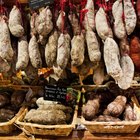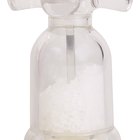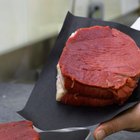
Whether your dry salami is Genoa, Milano or pepperoni and made with pork, veal or beef, it is by definition a preserved meat and long-lasting. Backpackers swear by salami's long shelf life, making both cooked and uncooked gourmet meals from it night after night in the wilderness. The preservation process makes salami long-lasting outside the refrigerator too, but there are still limits on how long it can be kept at room temperature.
Whole Salami
If your dry salami does not have a "Keep Refrigerated" label, it is a shelf-stable variety. The lack of a label means that if the casing is intact and not cut, the salami can be kept safely unrefrigerated for several years, note Sharon Tyler Herbst and Ron Herbst, authors of "The Deluxe Food Lover's Companion." On the other hand, the U.S. Department of Agriculture recommends that you limit the time on the shelf to six weeks even for uncut salami.
Cut Salami
Once you slice into the salami, you break the protective casing and harmful bacteria can enter into the sausage. Ironically, harmless bacteria are also used in curing salami. The white casing on the outside of salami is an edible mold called penicillim that blocks other bacteria from entering the sausage. Once salami is cut, put it in the refrigerator, where you can keep it for up to three weeks.
Safety
The curing process for salami, consisting of a mixture of salt, sodium nitrate and lactic acid bacteria and air-drying, kills off harmful bacteria. But because the salami has not been cooked, the USDA recommends that older adults, young children, pregnant women and people with weakened immune systems avoid eating dry salami because there is a risk that some harmful bacteria may still be present.
History
From the Italian "to salt," or "salare," salami has been made for hundreds of years by people all over the world who relied on its long shelf-life. Early Cyprians may have cured meats around 700 B.C. and Native American made a version called pemmican with buffalo and venison meats, fat, berries and herbs. Italian immigrants were among the early American salami-makers, bringing curing techniques to San Francisco, among other areas, in 1917.
Related Articles

How to Keep Sopressata Salami Soft

How to Dry Meat With Salt

Does a Sliced American Cheese Product ...
What Cut of Meat Do You Use to Make ...

Can I Eat Prosciutto Ham Without ...

Different Kinds of Cold Cuts

Different Kinds of Lunch Meat

How to Barbecue Bologna on a Charcoal ...

How to Cook Pancetta

Cheeses Similar to Feta

How to Sugar Cure Bacon

What Is Hog Casing Made Of?

How to Smoke Sausage in a Meat Smoker

How to Freeze Dry Sliced Salami

How to Keep Sopressata Salami Soft

Aged Cheeses That Do Not Melt

How to Make an Italian Cold Cut Sub

Can You Eat the Skin on Muenster Cheese?

List of Vegetarian Cheeses

How to Slice Round Steak for Jerky
References
- The Deluxe Food Lover's Companion; Sharon Tyler Herbst and Ron Herbst
- USDA Food Safety and Inspection Service: Sausages and Food Safety
Resources
Writer Bio
Susan Lundman began writing about her love of cooking, ingredient choices, menu planning and healthy eating after working for 20 years on children's issues at a nonprofit organization. She has written about food online professionally for ten years on numerous websites, and has provided family and friends with homemade recipes and stories about culinary adventures. Lundman received her M.A. from Stanford University.
Photo Credits
Goodshoot/Goodshoot/Getty Images